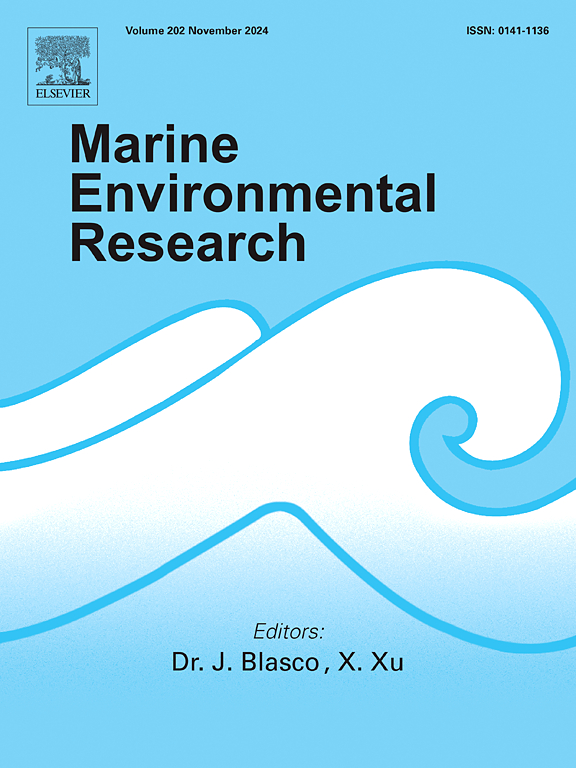利用远程视频觅食系统评估鱼类在非土著蓑鲉上的觅食行为
IF 3
3区 环境科学与生态学
Q2 ENVIRONMENTAL SCIENCES
引用次数: 0
摘要
有害和入侵性海洋大型藻类的扩散威胁着沿海生态系统,生物之间的相互作用,包括直接影响(如放牧)和间接影响(如营养级联,即一种物种通过与第三种物种的相互作用间接影响另一种物种),在决定当地群落对这些入侵的抵抗力方面起着至关重要的作用。本研究利用远程视频觅食系统(RVFS)研究了本地鱼类群落对本地(Halopteris scoparia、Sargassum vulgare)和非本地(Asparagopsis taxiformis)大型藻类的觅食行为和偏好。在三个地点部署了 54 个杂草罂粟,以展示这些大型藻类,同时还收集了相关的附生动物组合。视频分析表明,四种常见鱼类对本地大型藻类表现出偏好,这可能是由于底栖生物的存在而非草食的缘故。这一观察结果表明,这些鱼类认为大型藻类是它们喜欢的食物栖息地。与此相反,A. taxiformis则一直被避开,这表明它们融入当地食物网的程度有限。鱼类与大型藻类之间的相互作用以及表生动物的多样性因地点而异,凸显了这些动态变化的复杂性。这项研究有助于理解入侵大型藻类对生态的影响,并支持将 RVFS 作为一种工具,用于评估全球沿海生态系统中当地生物对非土著物种的抵抗力。本文章由计算机程序翻译,如有差异,请以英文原文为准。
Evaluating fish foraging behaviour on non-indigenous Asparagopsis taxiformis using a remote video foraging system
The proliferation of pest and invasive marine macroalgae threatens coastal ecosystems, with biotic interactions, including direct effects such as grazing and indirect effects such as the trophic cascades, where one species indirectly affects another through its interactions with a third species, play a critical role in determining the resistance of local communities to these invasions. This study examines the foraging behaviour and preference of native fish communities toward native (Halopteris scoparia, Sargassum vulgare) and non-indigenous (Asparagopsis taxiformis) macroalgae using the Remote Video Foraging System (RVFS). Fifty-four weedpops were deployed across three locations to present these macroalgae, while associated epifaunal assemblages were also collected. Video analysis revealed that four common fish species displayed preference towards native macroalgae, possibly due to by the presence of zoobenthos rather than herbivory. This observation suggests that these fish species identified the macroalgae as a habitat that harboured their preferred food items. In contrast, A. taxiformis was consistently avoided, suggesting limited integration into the local food web. Site-specific variations in fish-macroalgae interactions and epifaunal diversity highlighted the complexity of these dynamics. This study contributes to understanding of the ecological implications of invasive macroalgae and supports the use of RVFS as a tool for assessing local biotic resistance against non-indigenous species in coastal ecosystems globally.
求助全文
通过发布文献求助,成功后即可免费获取论文全文。
去求助
来源期刊

Marine environmental research
环境科学-毒理学
CiteScore
5.90
自引率
3.00%
发文量
217
审稿时长
46 days
期刊介绍:
Marine Environmental Research publishes original research papers on chemical, physical, and biological interactions in the oceans and coastal waters. The journal serves as a forum for new information on biology, chemistry, and toxicology and syntheses that advance understanding of marine environmental processes.
Submission of multidisciplinary studies is encouraged. Studies that utilize experimental approaches to clarify the roles of anthropogenic and natural causes of changes in marine ecosystems are especially welcome, as are those studies that represent new developments of a theoretical or conceptual aspect of marine science. All papers published in this journal are reviewed by qualified peers prior to acceptance and publication. Examples of topics considered to be appropriate for the journal include, but are not limited to, the following:
– The extent, persistence, and consequences of change and the recovery from such change in natural marine systems
– The biochemical, physiological, and ecological consequences of contaminants to marine organisms and ecosystems
– The biogeochemistry of naturally occurring and anthropogenic substances
– Models that describe and predict the above processes
– Monitoring studies, to the extent that their results provide new information on functional processes
– Methodological papers describing improved quantitative techniques for the marine sciences.
 求助内容:
求助内容: 应助结果提醒方式:
应助结果提醒方式:


